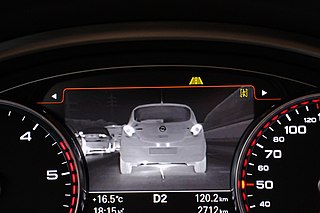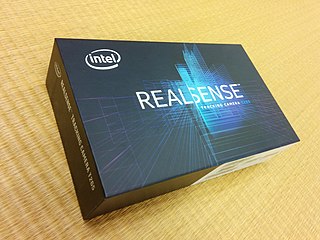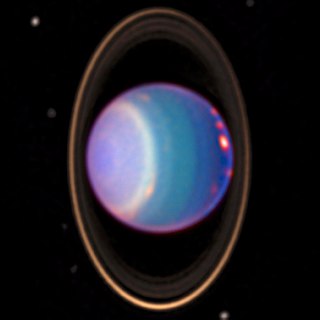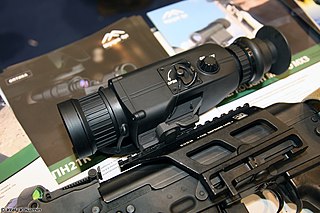 W
WAn automotive night vision system uses a thermographic camera to increase a driver's perception and seeing distance in darkness or poor weather beyond the reach of the vehicle's headlights. Such systems are offered as optional equipment on certain premium vehicles. The technology was first introduced in the year 2000 on the Cadillac Deville. This technology is based on the night vision devices (NVD), which generally denotes any electronically enhanced optical devices operate in three modes: image enhancement, thermal imaging, and active illumination. The automotive night vision system is a combination of NVDs such as infrared cameras, GPS, Lidar, and Radar, among others to sense and detect objects.
 W
WA cold shield is a device to protect an object from unwanted heating by thermal radiation or light. Usually it is a cooled object with low absorption and high reflectivity.
 W
WRAPTOR was a reconnaissance pod used by the Royal Air Force on its fleet of Tornado GR.4A and GR.4 aircraft. RAPTOR was manufactured by the Goodrich Corporation, initially part of UTC Aerospace Systems, but now part of Collins Aerospace.
 W
WDiffuse Infrared Background Experiment (DIRBE) was an experiment on NASA's COBE mission, to survey the diffuse infrared sky. Measurements were made with a reflecting telescope with 19 cm diameter aperture. The goal was to obtain brightness maps of the universe at ten frequency bands ranging from the near to far infrared. Also, linear polarization was measured at 1.25, 2.2, and 3.5 micrometers. During the mission, the instrument could sample half the celestial sphere each day.
 W
WDirectional Infrared Counter Measures (DIRCM) are a class of anti-missile systems produced to protect aircraft from infrared homing missiles, primarily MANPADS and similar simple systems.
 W
WThe EuroFirst Passive Infrared Airborne Track Equipment (PIRATE) is the Forward looking infrared (FLIR) / Infra-red search and track (IRST) for the Eurofighter Typhoon. It is produced by the EuroFIRST consortium consisting of Leonardo S.p.A. of Italy, Thales Land & Joint Systems of the UK, and Tecnobit of Spain. The system is mounted on the port side of the fuselage, forward of the windscreen and provides passive and thus undetectable and unjammable means of long range surveillance. In addition the system has been shown to locate stealth aircraft at a "significant distance" with further improvements in detection through software updates. PIRATE detects heat caused on an aircraft's skin caused by air friction.
 W
WFocal Plane Array testing is a specialized field of test engineering. Focal plane array (FPA) imaging devices are used in missile guidance sensors, infrared astronomy, manufacturing inspection, and thermal imaging. Focal plane array testing is the process of verifying and validating that these devices function correctly. Focal plane arrays are complex to develop, in some cases the fabrication process may have more than 150 steps, testing of these devices must ensure that each step has the desired result.
 W
WForward-looking infrared (FLIR) cameras, typically used on military and civilian aircraft, use a thermographic camera that senses infrared radiation.
 W
WMoira Gunn is both an academic and a professional journalist. She is perhaps best known as the host of the public radio program Tech Nation, its regular segment BioTech Nation, as well as the weekly tech-sci commentary, Five Minutes. It airs on the National Public Radio "NPR Now" channel at SiriusXM 122, public radio stations both nationally and internationally, and the Internet in a number of podcast syndication outlets podcast. A former NASA computer scientist and engineer, Dr. Gunn is an associate professor at the University of San Francisco, where she is the Director of Bioentrepreneurship, where her work on BioTech Nation dovetails with academic, reflecting the multidisciplinary nature of moving scientific breakthroughs on the lab bench through to the commercial products.
 W
WIn infrared astronomy, the H band refers to an atmospheric transmission window centred on 1.65 micrometres with a Full width at half maximum of 0.35 micrometres (in the near-infrared).
 W
WHyperspectral imaging, like other spectral imaging, collects and processes information from across the electromagnetic spectrum. The goal of hyperspectral imaging is to obtain the spectrum for each pixel in the image of a scene, with the purpose of finding objects, identifying materials, or detecting processes. There are three general branches of spectral imagers. There are push broom scanners and the related whisk broom scanners, which read images over time, band sequential scanners, which acquire images of an area at different wavelengths, and snapshot hyperspectral imaging, which uses a staring array to generate an image in an instant.
 W
WInfrared and thermal testing refer to passive thermographic inspection techniques, a class of nondestructive testing designated by the American Society for Nondestructive Testing (ASNT). Infrared thermography is the science of measuring and mapping surface temperatures. "Infrared thermography, a nondestructive, remote sensing technique, has proved to be an effective, convenient, and economical method of testing concrete. It can detect internal voids, delaminations, and cracks in concrete structures such as bridge decks, highway pavements, garage floors, parking lot pavements, and building walls. As a testing technique, some of its most important qualities are that (1) it is accurate; (2) it is repeatable; (3) it need not inconvenience the public; and (4) it is economical."
 W
WInfrared astronomy is a sub-discipline of astronomy which specializes in the observation and analysis of astronomical objects using infrared (IR) radiation. The wavelength of infrared light ranges from 0.75 to 300 micrometers, and falls in between visible radiation, which ranges from 380 to 750 nanometers, and submillimeter waves.
 W
WAn infrared countermeasure (IRCM) is a device designed to protect aircraft from infrared homing missiles by confusing the missiles' infrared guidance system so that they miss their target. Heat-seeking missiles were responsible for about 80% of air losses in Operation Desert Storm. The most common method of infrared countermeasure is deploying flares, as the heat produced by the flares creates hundreds of targets for the missile.
 W
WAn infrared detector is a detector that reacts to infrared (IR) radiation. The two main types of detectors are thermal and photonic (photodetectors).
 W
WInfrared homing is a passive weapon guidance system which uses the infrared (IR) light emission from a target to track and follow it. Missiles which use infrared seeking are often referred to as "heat-seekers" since infrared is radiated strongly by hot bodies. Many objects such as people, vehicle engines and aircraft generate and emit heat and so are especially visible in the infrared wavelengths of light compared to objects in the background.
 W
WIn infrared photography, the film or image sensor used is sensitive to infrared light. The part of the spectrum used is referred to as near-infrared to distinguish it from far-infrared, which is the domain of thermal imaging. Wavelengths used for photography range from about 700 nm to about 900 nm. Film is usually sensitive to visible light too, so an infrared-passing filter is used; this lets infrared (IR) light pass through to the camera, but blocks all or most of the visible light spectrum.
 W
WInfrared Physics and Technology is a peer-reviewed scientific journal published by Elsevier devoted to the publication of new experimental and theoretical papers about applications of physics to the field of infrared physics and technology.
 W
WAn infrared search and track (IRST) system is a method for detecting and tracking objects which give off infrared radiation such as jet aircraft and helicopters.
 W
WAn infrared telescope is a telescope that uses infrared light to detect celestial bodies. Infrared light is one of several types of radiation present in the electromagnetic spectrum.
 W
WIntel RealSense Technology is a product range of depth and tracking technologies designed to give machines and devices depth perception capabilities. The technologies, owned by Intel are used in autonomous drones, robots, AR/VR, smart home devices amongst many others broad market products.
 W
WInfrared Control Freak 360 (IRCF360) is a 360-degree proximity sensor and a motion sensing devices, developed by ROBOTmaker. The sensor is in BETA developers release as a low cost sensor for use within research, technical and hobby projects.
 W
WIn infrared astronomy, the J band refers to an atmospheric transmission window centred on 1.25 micrometres.
 W
WKinect is a line of motion sensing input devices produced by Microsoft and first released in 2010. The devices generally contain RGB cameras, and infrared projectors and detectors that map depth through either structured light or time of flight calculations, which can in turn be used to perform real-time gesture recognition and body skeletal detection, among other capabilities. They also contain microphones that can be used for speech recognition and voice control.
 W
WIn infrared astronomy, the L band is an atmospheric transmission window centred on 3.5 micrometres.
 W
WIn infrared astronomy, the M band is an atmospheric transmission window centred on 4.7 micrometres.
 W
WMicrosoft PixelSense is an interactive surface computing platform that allows one or more people to use and touch real-world objects, and share digital content at the same time. The PixelSense platform consists of software and hardware products that combine vision based multitouch PC hardware, 360-degree multiuser application design, and Windows software to create a natural user interface (NUI).
 W
WIn infrared astronomy, the N band refers to an atmospheric transmission window centred on 10 micrometres.
 W
WThe Near Infrared Camera and Multi-Object Spectrometer (NICMOS) is a scientific instrument for infrared astronomy, installed on the Hubble Space Telescope (HST), operating from 1997 to 1999, and from 2002 to 2008. Images produced by NICMOS contain data from the near-infrared part of the light spectrum.
 W
WNight vision is the ability to see in low-light conditions. Whether by biological or technological means, night vision is made possible by a combination of two approaches: sufficient spectral range, and sufficient intensity range. Humans have poor night vision compared to many animals, in part because the human eye lacks a tapetum lucidum.
 W
WNon-contact thermography, thermographic imaging, or medical thermology is the field of thermography that uses infrared images of the human skin to assist in the diagnosis and treatment of medical conditions. Medical thermology is sometimes referred to as medical infrared imaging or tele-thermology and utilizes thermographic cameras. According to the American Academy of Thermology, Medical Thermology practitioners are licensed health care practitioners who utilize IR imaging in consistent with medically established paradigms of care. Non-medically licensed alternative practitioners who are not held to the same standard may offer thermography services but that should not be confused with the field of medical thermology.
 W
WA pyrometer is a type of remote-sensing thermometer used to measure the temperature of distant objects. Various forms of pyrometers have historically existed. In the modern usage, it is a device that from a distance determines the temperature of a surface from the amount of the thermal radiation it emits, a process known as pyrometry and sometimes radiometry.
 W
WA Quantum Well Infrared Photodetector (QWIP) is an infrared photodetector, which uses electronic intersubband transitions in quantum wells to absorb photons. In order to be used for infrared detection, the parameters of the quantum wells in the quantum well infrared photodetector are adjusted so that the energy difference between its first and second quantized states match the incoming infrared photon energy. QWIPs are typically made of gallium arsenide, a material commonly found in smartphones and high-speed communications equipment. Depending on the material and the design of the quantum wells, the energy levels of the QWIP can be tailored to absorb radiation in the infrared region from 3 to 20 µm.
 W
WRAPTOR was a reconnaissance pod used by the Royal Air Force on its fleet of Tornado GR.4A and GR.4 aircraft. RAPTOR was manufactured by the Goodrich Corporation, initially part of UTC Aerospace Systems, but now part of Collins Aerospace.
 W
WSpecim, Spectral Imaging Ltd is a European technology firm headquartered in Oulu, Finland. Specim manufactures and sells imaging spectrographs, hyperspectral cameras and systems. Specim's airborne AISA hyperspectral cameras have been utilized for example in monitoring the environmental effects of major industrial catastrophes such as Deepwater Horizon oil spill and Red mud spill.
 W
WThe Spitzer Infrared Nearby Galaxies Survey (SINGS) was a survey of 75 galaxies using the Spitzer Space Telescope, carried out between 2003 and 2006.
 W
WA thermographic weapon sight, thermal imagery scope or thermal weapon sight is a sighting device combining a compact thermographic camera and an aiming reticle. They can be mounted on a variety of small arms as well as some heavier weapons.
 W
WA thermographic camera is a device that creates an image using infrared(IR) radiation, similar to a common camera that forms an image using visible light. Instead of the 400–700 nanometre (nm) range of the visible light camera, infrared cameras are sensitive to wavelengths from about 1,000 nm to about 14,000 nm (14 μm). The practice of capturing and analyzing the data they provide is called thermography.
 W
WInfrared thermography (IRT), thermal video and/or thermal imaging, is a process where a thermal camera captures and creates an image of an object by using infrared radiation emitted from the object in a process, which are examples of infrared imaging science. Thermographic cameras usually detect radiation in the long-infrared range of the electromagnetic spectrum and produce images of that radiation, called thermograms. Since infrared radiation is emitted by all objects with a temperature above absolute zero according to the black body radiation law, thermography makes it possible to see one's environment with or without visible illumination. The amount of radiation emitted by an object increases with temperature; therefore, thermography allows one to see variations in temperature. When viewed through a thermal imaging camera, warm objects stand out well against cooler backgrounds; humans and other warm-blooded animals become easily visible against the environment, day or night. As a result, thermography is particularly useful to the military and other users of surveillance cameras.
 W
WL3Harris Wescam, stylized as L3Harris WESCAM, is a Canadian company specializing in the production of gyro-stabilized, EO-IR imaging systems. Wescam Inc. is a subsidiary of L3Harris Technologies. The name has become synonymous with cameras of the type although several organizations around the world manufacture similar systems. Wescam is based in Burlington, Ontario, Canada.
 W
WThe ZG 1229 Vampir 1229, also known by its code name Vampir, was an active infrared device developed for the Wehrmacht for the Sturmgewehr 44 assault rifle during World War II, intended primarily for night use. Designed by C.G. Haenel, the Vampir was used in small numbers in the Eastern Front.
 W
W